 Leading Blog | Posts by Month |
 Leading Blog | Posts by Month |
11.30.23

Leading Thoughts for November 30, 2023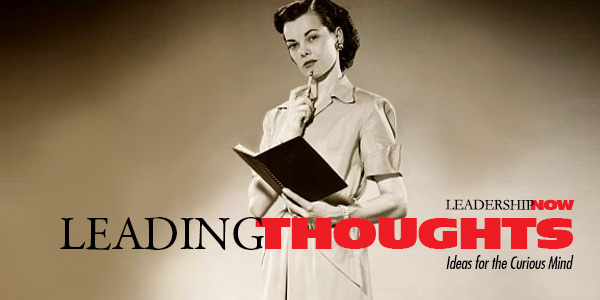
IDEAS shared have the power to expand perspectives, change thinking, and move lives. Here are two ideas for the curious mind to engage with: Bob Chapman and Raj Sisodia on stewardship: “People come into this world with gifts and talents, full of possibilities and unrealized potential. Our responsibility as leaders is to help them realize those possibilities by looking for the talents and goodness that exist in them and inspiring them to become what they are meant to be. Leaders are called to help people become what they were put on this earth to be as individuals and as part of a team or community.” Source: Everybody Matters: The Extraordinary Power of Caring for Your People Like Family Barbara Kellerman on the context of leadership: “We need to think of leadership as a creative act for which leaders and followers both are educated, for which leaders and followers both are prepared over a lifetime of learning.” Source: The End of Leadership Look for these ideas every Thursday on the Leading Blog. Find more ideas on the LeadingThoughts index.
Posted by Michael McKinney at 10:48 AM

LeadershipNow 140: November 2023 Compilation
See more on
Posted by Michael McKinney at 06:45 AM
11.27.23

5 Leadership Development Practices to Kick to the Curb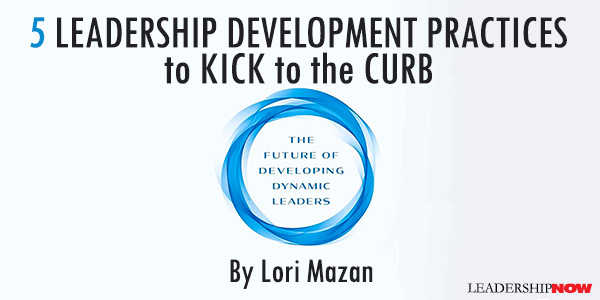
IN MY THIRTY YEARS as an executive coach, I have seen a lot of change — the complete digital transformation of the workplace, increased diversity of the labor market, the shifting role of employers. But one thing that has largely remained unchanged has been the approach to leadership development. Even though the world looks nothing like it did 30 years ago, organizations still cling to strategies and methodologies developed in the 20th century. Here are five outdated practices that organizations need to kick to the curb immediately: 1. Limiting the definition of leadership Many have asked me how to define a leader, but I have refused. There is no one way to be a leader. Effective leadership does not rely upon a standard set of characteristics like charisma or aggressiveness. Narrowly defining leadership restricts innovation by excluding countless points of view and modes of operating. Yet, many learning and development strategies are built towards forcing leaders to fit themselves into a restrictive mold. When leaders are pressured into leadership styles that go against their natural way of operating, they are set up for failure. It’s like wearing a set of clothes that don’t fit. Leaders feel self-conscious and uncomfortable. They end up focusing on themselves instead of the people and organization they are leading. Opening the definition of leadership empowers leaders to play to their strengths rather than confining them to operate within a set style. And it opens the door to greater diversity in the leadership ranks and pipeline. 2. Focusing solely on skill development Early in my career, I worked as a corporate trainer. Sessions were standardized training with 30 or more participants working on building skills or horizontal development. After the sessions, there was time for questions, and often, I would be asked, “This is great, but how do I actually use this in my day-to-day?” Vertical development answers that question by building a leader’s capabilities and capacities. Capabilities are sets of skills and the ability to apply these within the context of the moment. Capacity is a leader’s ability to contain, manage, or affect change in the evolving circumstances within their role. Traditional training and skill development are needed, but without vertical development to contextualize the use of these skills, leaders will fail to transfer these skills into their daily routines. In short, without vertical development, training dollars are wasted. 3. Using standard 360 assessment tools Most assessment tools — like most leadership development models — were created in the last century and no longer accurately reflect a leader’s developmental needs. The typical 360 assessment is too linear and only provides a snapshot of the leader at a single point in time. They provide limited value in our current fast-paced, complex, constantly changing, non-binary business environment. Organizations need a way to measure and track a leader’s development over time rather than a one-and-done assessment. Assessments should rely on a feedback loop from leaders, managers, and coaches to evaluate and track progress. Insights could then be used to develop new goals, creating a continuous learning experience. 4. Relying on ranked or traditional performance evaluations In the early 2000s, companies were beginning to abandon performance evaluations because they provided very little helpful information regarding talent decisions and development. Typically, evaluation scores are determined subjectively, which can often lead to disagreements between managers and direct reports on whether expectations are being met. Performance evaluations are also a massive drain on manpower and resources. Yet, having no alternative, performance evaluations have once again become popular because organizations feel they must “do something” to evaluate workers. Our company has decided to leave performance evaluations in the past where they belong. We have opted for manager/employee alignment tools. Instead of relying on a once-a-year subjective evaluation, our leaders work regularly with direct reports to ensure that everyone on the team is aligned to the same priorities, goals, and objectives. 5. Manually managing leadership development programs I recently hosted a webinar and polled the audience on how they managed their programs, and more than half of the respondents said they either used spreadsheets or manually tracked everything. When programs are manually managed, the cost and labor associated with development programs become unsustainable. Worse, manual management opens the door to human errors like coach or mentor mismatches, mis-scheduling, and loss of data. With today’s technology, there is absolutely no excuse to manage leadership development programs manually. A well-designed leadership development platform can eliminate the pitfalls associated with manual management, while also increasing engagement among leaders. Technology can eliminate the guesswork when matching coaches and coachees, scheduling, and tracking development. The right platform will provide a throughline between development and return on investment. Is your organization guilty of clinging to these outdated practices? If so, it’s time to finally get your company’s leadership development into the 21st century. Failing to do so will guarantee a weak leadership bench that is unprepared to adapt and thrive within today’s ever-changing economic environment.  
Posted by Michael McKinney at 07:45 AM
11.23.23

Leading Thoughts for November 23, 2023
IDEAS shared have the power to expand perspectives, change thinking, and move lives. Here are two ideas for the curious mind to engage with: Anthony Iannarino on how to start practicing gratitude: “One way to start a gratitude practice is to take an inventory of all things for which You should be grateful. Include every good thing you have now and good things you have had in the past, including the experiences you’ve had throughout your life. It is sometimes easier to make a list, as it challenges your mind to fill in the blanks. This list should include the people who have had a profound impact on your life. Or negativity bias has us constantly looking for what is wrong. An inventory of what you are grateful for can help you recognize what you have that is positive and worth being grateful for.” Source: The Negativity Fast: Proven Techniques to Increase Positivity, Reduce Fear, and Boost Success Brian Johnson on gratitude: “As Tal Ben-Shahar tells us: “The word appreciate has tw0 meanings. The first meaning is to be thankful,’ the opposite of taking something for granted. The second meaning is ‘to increase in value’ (as money appreciates in the bank). Combined, these two meanings point to a truth that has been proved repeatedly in research on gratitude: when we appreciate the good in our lives, the good grows and we have more of it. The opposite, sadly, is also true: when we fail to appreciate the good—when we take the good in our lives for granted—the good depreciates.” Source: Areté: Activate Your Heroic Potential Look for these ideas every Thursday on the Leading Blog. Find more ideas on the LeadingThoughts index.
Posted by Michael McKinney at 09:08 AM
11.20.23

The Leaders Our Companies Need: Lessons We Can Learn from Historical Luminaries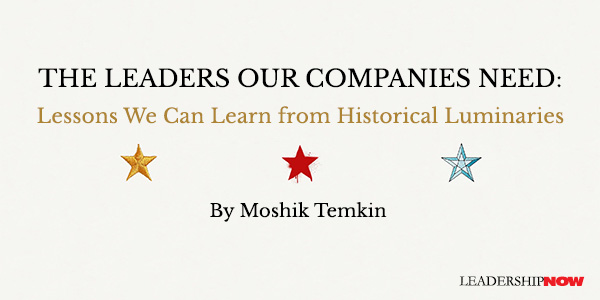
IF YOU ENTER a bookstore and peruse the shelves for books on famous leaders in history, you’ll likely find a recurring cast of characters staring at you. Winston Churchill. Napoleon Bonaparte. Abraham Lincoln. Mao Zedong. Keep browsing and you’ll encounter another variant of this literature featuring prominent men (and sometimes women) in the business or corporate world: Bill Gates. Elon Musk. Warren Buffett. Carlos Slim. Jeff Bezos. With varying degrees of nuance, these people are treated as heroes, role models, and inspirations. They’re portrayed as uniquely powerful individuals — able to overcome, through sheer force of will or ruthless intelligence, the obstacles they faced. The message from this literary cottage industry is that where there’s a will, there’s a way. It’s hard to escape this view of leaders and leadership. But what qualities do our celebrated leaders of industry embody that make them successful? Is it their ability to increase the company’s value? Effectively lead through a major transition? Inspire others through a shared passion? And, importantly, what qualities can others emulate to themselves become more effective leaders? Learning how to be good leaders doesn’t involve formulas or abstractions. It can, however, be edified through examining tangible illustrations of leaders and leadership from history. How leaders operated within, or pushed against, the constraints of their time illustrate characteristics of responsibility, vision, sacrifice, and more. Actions of standout leaders through history who have had to make decisions in the direst circumstances, impose a radical new vision, or stand up to injustice or oppression, continue to echo as archetypes of leadership. Let’s examine the qualities of some prominent leaders from the past to reveal the sort of leaders and leadership that are needed to tackle the problems facing us today. Responsibility to the People: FDR and the Great Depression History shows us that truly important leaders emerge in times of crisis. When there is peace and economic prosperity, leaders can do well, but their main role is one of management — making sure things stay stable. When the Great Depression hit, President Herbert Hoover, while not personally responsible for the Wall Street crash, attempted to maintain a management role but failed to address or even take into full account the suffering of the American people. Hoover came off as callous and detached. He was widely admired and popular when he entered the White House in 1929, but his loss to Franklin D. Roosevelt in 1932 was the biggest landslide in American electoral history. A striking feature of Roosevelt’s political success was that he became an admired champion of the poorest Americans. Roosevelt’s New Deal — the policies that aimed to bring an end to the Depression through large public investment and by putting Americans to work — didn’t necessarily achieve its goals in purely “economic” terms (the US economy remained “depressed” throughout the 1930s), but it accomplished something more important: it gave people hope, restored their morale and self-respect, and showed them a kind of leadership that put the public interest first. Roosevelt’s energy and his manner of speaking had a certain charisma that Hoover’s lacked. He gave the impression that he intended to match his words with actions. But he also conveyed the sense that he felt a personal responsibility, as president and leader, for how people were faring. Enacting a Purposeful Vision: Margaret Thatcher’s Political Ideology Former British Prime Minister Margaret Thatcher’s influence stretches further, and goes deeper, than just Britain. In fact, we live in a world she helped make and that came straight out of her vision. Many consider her forceful acts to privatize public services, dismantle the remnants of socialism, and favor the wealthy as “job creators” as ending an era of stagnation, unproductive industries, and social decay. Dubbed “the Iron Lady,” she modernized Britain’s economy by putting almost all state assets up for sale, defeating trade unions, championing entrepreneurship and the financial sector, and creating the economic and social landscape Britain still has today. The Thatcherite outlook remains dominant, in Britain and elsewhere, but that doesn’t mean it’s universally loved or that it will last. The deadly, debilitating COVID pandemic, featuring a virus that ignored national borders and private interests and killed millions of people, exposed the limitations of the Thatcherite worldview, with its emphasis on individualism and jingoism — both of which took a bad situation and made it worse. And as we face a global climate crisis, the reckoning with Thatcher’s legacy will grow. Even if many of our leaders continue to repeat Thatcherite pieties, only drastic changes in how we collectively live, govern, and organize our economy will offer any hope for solutions. Self-Sacrifice For a Cause: MLK’s Stand Against Racial Injustice Reverend Martin Luther King, Jr., an eloquent Baptist minister with a Ph.D. in theology, unwittingly became the leader of the Civil Rights Movement in the U.S. in the late 1950s and 1960s until he was assassinated at age 39. His passionate orations reminded Americans of their creed that “all men were created equal” and ignited massive demonstrations in the form of “freedom rides” in southern states, voter registration drives, sit-ins, and marches. King showcased morally compelling, truth-telling leadership and drew attention throughout the nation and around the world to the persistence of segregation and racism. In this regard, he and his followers were wildly successful. Yet, in the 50-plus years since King’s death, the gap between the richest and the poorest Americans has grown exponentially, and African Americans remain among the poorest — and by far the most incarcerated — of the population. We are all living through history, and while we’re products of the past, we’re also the makers of the future. Whether through responsibility, vision, or sacrifice, or other influential traits, we must hone the leadership qualities that will shape the businesses — and the society — we need today and into the future.  For the past decade, Moshik Temkin has challenged his students at Harvard University’s Kennedy School of Government and around the world to grapple with the nature of leadership as part of his wildly popular course “Leaders and Leadership in History.” Now, in Warriors, Rebels, and Saints, Temkin refashions the classroom for a wider audience. Learn more at moshiktemkin.com. 
Posted by Michael McKinney at 09:26 AM
11.17.23

How Leaders Can Build an Autonomous Work Environment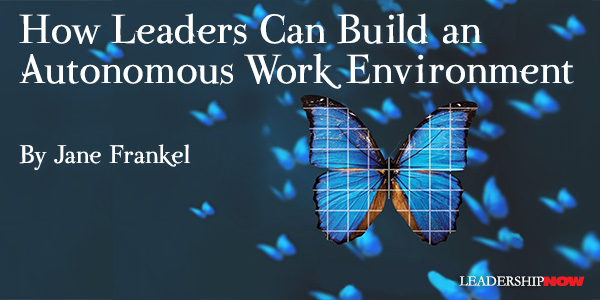
IN HIS BOOK Thank You for Being Late, author and award-winning journalist Tom Friedman argues that to understand the twenty-first century, you must realize that “the planet’s three largest forces”—technology, globalization, and climate change—are accelerating all at once. As a business leader, you already get that. But, at the same time, you need to navigate other realities, too—like, for starters, figuring out your own goals and understanding and performing well in your job. Not to mention that the pandemic caused unprecedented distress among workers. Being displaced from their physical work environments, missing their colleagues socially and collaboratively, and losing much of their managers’ usual support, they became increasingly disengaged. They also grew unsure of how to take control of their purpose at work—and in life. Today, however, workers have no choice other than to rise to the occasion: to do their jobs well, to make good and relevant decisions, and to clearly contribute to their organization’s mission and success. And to do all that and more autonomously. But, as reiterated by recent research by Boston Consulting Group, workers first need agency and control—the tenets of autonomy. And, importantly, agency and control require what I call the three selfs: self-confidence, self-accountability, and self-sufficiency. And those selfs must be built and nurtured to take hold. Leaders Must Rise to the Occasion, Too As a leader, your role in creating an autonomous work environment cannot be overstated. You alone have the power to build and nurture workers’ three selfs, and to foster their agency and control. Moreover, to be autonomous in their work, people need to really feel your trust as their leader. And that, in turn, can help them become more and more invested in their own growth and contributions. To get started, here are seven ways to create an autonomous work environment. 1. Reinforce an autonomous narrative. Share your organization’s mindset and narrative around autonomy. Be sure to include current goals for workers’ performance and the ways in which they’re trusted and free to go about doing their jobs. 2. Keep people fully informed. Communicate all relevant information to employees, partners, and other stakeholders on a regular, if not real-time, basis. 3. Have a digital nervous system. Supply workers with a framework of fundamental data and information for analysis in areas such as organizational strategy, industry trends and events, and potential revenue opportunities. 4. Create a project structure. Foster a learning orientation, including an ongoing analysis of prior projects, workflows, and results and outcomes. 5. Recognize and reward value creation. Spotlight key creators and contributors, sharing exactly how they’re adding value to the enterprise. 6. Hold regular reflection sessions. Help people reflect on new business ideas and ways of working, always reinforcing opportunities for intrapreneuring. 7. Balance independence with dependence. Tap into a variety of management theories to emphasize the importance of both working independently and collaborating with others to benefit from their unique expertise and contributions. In closing, as a business leader today, it’s an imperative to create an autonomous work environment. Amid accelerating change, your people need agency and control—imbued by the three selfs—in order to work autonomously, to uncover new opportunities to add value, and to grow and thrive in the 21st-century workplace.  
Posted by Michael McKinney at 12:54 PM
11.16.23

Leading Thoughts for November 16, 2023
IDEAS shared have the power to expand perspectives, change thinking, and move lives. Here are two ideas for the curious mind to engage with: Brad Stulberg on getting comfortable with change: “If we cannot get comfortable (or at least comfortable enough) with the fact that everything changes, we risk going through life at an arm’s length from its most poignant offerings. In trying to protect ourselves from the experience of change, we end up limiting the depth of our lives.” Source: Master of Change: How to Excel When Everything Is Changing – Including You William Vanderbloemen on self-awareness: “Being self-aware makes you better at finding solutions. Knowing yourself comes with a guaranteed pinch: (or more) of humility, so when a self-aware person is faced with a challenge, they can decenter themselves from the issue. Being self-aware is knowing all about you while knowing that it’s not all about you. Whatever the crisis, the Self-Aware remain even-keeled and committed to the goal.” Source: Be the Unicorn: 12 Data-Driven Habits that Separate the Best Leaders from the Rest Look for these ideas every Thursday on the Leading Blog. Find more ideas on the LeadingThoughts index.
Posted by Michael McKinney at 08:33 AM
11.11.23

Most Americans Own Books — But Not Many
 YouGov asked more than 29,000 Americans whether they owned books and found that the vast majority did: 85% said they owned at least one physical book. They report the following findings: However, one in five Americans say they own between one and ten physical books. Including the 9% of respondents who say they own no physical books, at least 69% of Americans own no more than 100 books. Another 25% own at least 100 books, including 4% who own between 500 and 1,000 books and 3% who own more than 1,000 volumes. Looking at age, 19% of Americans between 31 and 35 years old own at least 100 physical books, compared to 31% of those between 51 and 55 and 42% of those between 71 and 75. The higher the education level, the more books they own. For example, among 31- to 35-year-olds, 8% of people whose highest level of education is a high school diploma own at least 100 books, compared to 25% of people in the same age range with postgraduate degrees. When it comes to how they arrange their books, 29% of book-owning Americans say they don’t organize their books. 22% of book-owning Americans organize their books by genre or subject. Sorting books by color is more popular among younger Americans. Among book owners under 30, 6% say they sort by color, compared to less than 1% of book owners who are 65 or older.
Posted by Michael McKinney at 06:24 AM
11.10.23

Michael Caine: Use the Difficulty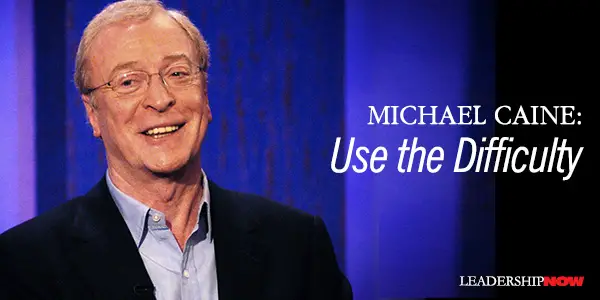
PROFESSIONAL golfer Phil Mickelson has played golf with a lot of elite performers like Tiger Woods, Michael Jordan, and Tom Brady. He said, “The biggest difference between people who get the most out of their talent and those who don’t is the ability to retake control of your thoughts, to quickly turn it around when things start going bad.” He adds, they “have the ability to retake control of their thoughts, to refocus on what they want to have happen, on where they want the ball to go. When things start going bad, they have the ability to quickly turn it around.” They are resilient. In an interview with BBC celebrity chat host Michael Parkinson, Michael Caine put it this way: PARKINSON: I came across a line which I just wanted you to sort of explain to me. You said that if you did have one philosophy of life, it was use the difficulty. Yes, use the difficulty. What does that mean? CAINE: Well, yeah. I was rehearsing a play when I was a very young actor, and I had to come into this scene—it was a stage play—I’m behind the flats waiting to open the door. There was an improvised scene between a husband and wife going on inside, and they got carried away, and they started throwing things. And he threw a chair, and it lodged in the doorway. And I went to get open the door, and I just got my head round, and I said, “I’m sorry, sir, I can’t get in.” He said, “What do you mean?” He sees a chair there, and he said to me, “Use the difficulty.” “What do you mean?” He said, “Well, if it’s a comedy, fall over it. If it’s a drama, pick it up and smash it.” He said, “Use the difficulty.” Now, I took that into my own life. You asked my children; they said directly if anything bad happens, they go, “Gotta use the difficulty. How can we work—what can we get out of this?” You know, use the difficulty. And so, there’s never anything so bad that you cannot use that difficulty in. If you can use it a quarter of one percent to your advantage, you’re ahead. You didn’t let it get you down. You know that’s my philosophy: use the difficulty. Also added philosophy is avoid them if you can’t!
Posted by Michael McKinney at 06:36 AM
11.09.23

Leading Thoughts for November 9, 2023
IDEAS shared have the power to expand perspectives, change thinking, and move lives. Here are two ideas for the curious mind to engage with: William H. Danforth, founder of the Ralson Purina Company on giving your life away: “Our most valuable possessions are those which can be shared without lessening: those which, when shared, multiply. Our least valuable possessions are those which, when divided, are diminished.” Source: I Dare You Charlie Gilkey on dragons: “There be dragons on the journey to thriving and doing your best work. Dragons aren’t a signal that we’re on the wrong road but rather that we’re on the right road. So the next time you’re dismayed or hesitant because of a dragon guarding the way forward, embrace that it’s there precisely because it’s the way forward and charge headlong at it. You were made to beat dragons.” Source: Start Finishing: How to Go from Idea to Done Look for these ideas every Thursday on the Leading Blog. Find more ideas on the LeadingThoughts index.
Posted by Michael McKinney at 05:47 AM
11.07.23

Out of Context: The Difference Between Character and PersonalityCHARACTER is often confused with personality, but they’re not the same. Personality is your predisposition—your basic instincts for how to think, feel, and act. Character is your capacity to prioritize your values over your instincts. Knowing your principles doesn’t necessarily mean you know how practice them, particularly under stress or pressure. It’s easy to be proactive and determined when things are going well. The true test of character is whether you manage to stand by those values when the deck is stacked against you. If personality is how you respond on a typical day, character is how you show up on a hard day. Personality is not your destiny—it’s your tendency. Character skills enable you to transcend that tendency to be true to your principles.
Posted by Michael McKinney at 07:28 AM
11.06.23

The Performance Paradox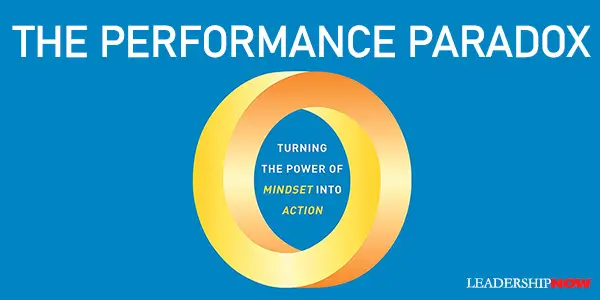
DO YOU get stuck in chronic performance? It’s that pressure you feel to get every task done as flawlessly as possible—and then some. A never-ending game of catch-up. So, we work harder to get things done. Hard work leads to better performance, right? The answer to that question is what Eduardo Briceño calls The Performance Paradox. The performance paradox is the counterintuitive phenomenon that if we want to improve our performance, we have to do something other than just perform. No matter how hard we work, if we only do things as best as we know how, trying to minimize mistakes, we get stuck at our current levels of understanding, skills, and capabilities. Too often, the performance paradox tricks us into chronic performance, which leads to stagnation. If we focus only on performing, our performance suffers. So, if working harder isn’t the answer, what do we do? The answer lies in learning to learn—a mindset of growth—in conjunction with performance. Briceño calls it the Learning Zone. It’s filled with curiosity, experimentation, and change. When used in combination the Performance Zone, we grow into higher levels of performance. Rather than just doing things the best we know how, we learn beyond the known to new levels of performance. “Regular engagement in the Learning Zone allows you to uncover and learn ways to work smarter, more efficiently, and more effectively.” It’s not just learning from doing but learning while doing that will lead us to higher levels of performance. “Improvement and high performance in any domain come down to making sure we engage in two distinct but equally powerful states of mind: the Learning Zone and the Performance Zone. Each has a different purpose and requires a distinct focus and set of tools.” Both mindsets can be used simultaneously.
Briceño explains how to integrate learning into doing. A know-it-all culture kills superior performance. The Performance Zone can provide valuable feedback if we are looking for it. Learning provides the catalyst to push us out of our comfort zone, stay relevant, and build our skills to perform smarter. 
Posted by Michael McKinney at 01:02 PM
11.03.23

Moving Beyond Company Organization Silos: Lessons from the Aviation Industry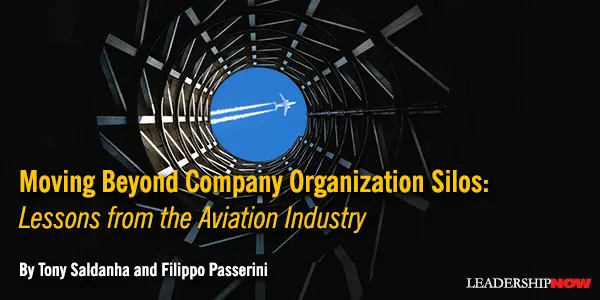
IF YOU’VE HAD to be on a plane in the last year or so, especially within the U.S., you’d likely agree with the NBC News proclamation that “the days of fun flying are long gone.” Between surging demand, labor shortages, outdated air traffic management, and travel reservation I.T. systems, air travel feels a bit more like a chore than like a treat. In the U.S., airline companies have pointed fingers at the Federal Aviation Administration (FAA) as the biggest cause of outages, even as the FAA has fired back at airlines. That’s a shame because the aviation industry as a whole still continues to be an industry model for how to operate with extremely high reliability despite having a highly fragmented set of organizational entities. Yes, we realize this sounds counterintuitive to anyone who’s dealt with a flight delay or a lost bag, but hear us out. If you think the business processes in your own company are complex, try running an operation globally that moves 5 billion passengers every year in roughly 25,000 commercial aircraft, via 15,000 airports located in 195 countries. And do that with over 99.999999 percent reliability. And just to make things interesting, do it in a decentralized organizational construct where laws, standards, and procedures aren’t as tightly controllable as within a single company. There’s no single CEO-like entity and no hierarchy for single accountability. In fact, deep lessons can be taught from aviation for most industries and companies who want to operate efficiently and effectively across organizational silos — those insidious barriers that wreak havoc on a company’s efficiency, collaboration, and, ultimately, its bottom line. The Insidious Effects of Organizational Silos First, what exactly are organizational silos? They aren’t the structures you’ll find on a farm, nor are they ancient fortifications protecting valuable treasures. They’re the metaphorical walls that separate different departments or teams within an organization. These walls are worse than the physical ones. They result in information hoarding and lack of communication. The biggest challenge for companies when it comes to operational excellence is siloed behavior. Even worse, functional processes — finance, human resources, sales, etc. — become ineffective with time, as they operate in silos as the company grows. This issue can become a major performance barrier. Recall how the U.S. Federal Bureau of Investigation (FBI) faced significant challenges in the aftermath of the 9/11 attacks. The lack of information sharing between different divisions hindered its ability to prevent the attacks. This tragic example demonstrates how silos can have real-world consequences. What We Can Learn from Aviation Regarding Moving Beyond Siloed Operations The aviation industry operates with high reliability despite its massive complexity. True, we can point to the fact that airplanes are massively engineered for reliability, but let’s look beyond the machinery. The industry directly employs more than 11 million people with varying capabilities around the world. They operate everything from ticketing to airport operations, to aircraft maintenance, to luggage and food services. The fact that such a complex, decentralized, sprawling operation delivers reliable (albeit not always likable) results is a minor miracle. The aviation industry can teach us about business process excellence in decentralized and complex setups. For instance, how has it minimized the defects that occur in handoffs from one team to another? And how does it address the organization issues of functional silos across thousands of companies? To understand how aviation has achieved process excellence, we need to back up a bit. It’s helpful to first understand the various stages involved in improving business processes. In general, business processes achieve excellence via five discrete layers of action: Fix non-standard processes: This is the starting point. Imagine what might happen if there were different steps for each country, or each airline, when it came to handling Air Traffic Controllers’ (ATC) control transfers. That’s the first step in improving processes. Synchronize siloed processes: Imagine if ATC activities were standard but siloed off from other aviation processes, such as airport gate management. Handoff errors would result. This step addresses that. Execute End-to-End (E2E) processes consistently: Assume that terminal check-in to gate management to ATC processes have been synchronized, but executional discipline is spotty. That can occur because it takes time to stabilize processes. Handoff errors may still occur. Add robust fail-safe designs to E2E process execution: Assume that processes from terminal check-in all the way to ATC are well executed. However, if no fail-safe procedures have been designed for the rare situations where problems occur, there will be occasional blowups. That’s because while processes are efficient E2E, there’s no Unified Accountability for an employee to circumvent or fix perfect-storm-type issues. Design roles for Unified Accountability of Outcomes: At this stage, employees are empowered both to achieve near-zero defects and to constantly evolve processes to keep up process excellence. The aviation industry has designed its business processes for clear handoffs and accountability. For instance, there’s clear accountability for customer outcomes at each step of the passenger’s journey — the check-in agent for checking in, the gate agent for boarding, the pilot for in-flight travel and safety, the ATC for cross-airplane safety, and so on. By contrast, business processes in most organizations still struggle with siloed accountability. Take, for instance, the order-to-cash (O2C) or the expanded quote-to-cash (QTC) business process, which runs from taking customer orders, to processing them in an I.T. system to delivering the product via logistics operations, to collecting the cash from customers. There is, on average, a 30 percent loss of efficiency in operating this across the siloed functions of sales, I.T., logistics, and finance. And that loss doesn’t account for the impact on sales growth. A study by McKinsey specific to the business-to-business (B2B) area suggests that businesses that optimize QTC for end-to-end accountability significantly outperform peers that don’t. They grow four times versus the competition by adding more new accounts, expanding existing accounts, and retaining them at higher rates. And the opportunity only grows when country and regional organization silos are factored in. What You Can Do to Operate Beyond Organizational Silos The key is to drive towards clear and unified E2E accountability for a process outcome. The driver of Unified Accountability is one of the three levers of revolutionizing business operations. Here are the initial steps to get going:
Finally, remember that when it comes to organizational silos, the best strategy is to tear them down before they tear your company apart.  
Posted by Michael McKinney at 06:40 AM
11.02.23

Leading Thoughts for November 2, 2023
IDEAS shared have the power to expand perspectives, change thinking, and move lives. Here are two ideas for the curious mind to engage with: Prasad Kaipa and Navi Radjou on wisdom: “Wisdom itself grounds us, helping us to shift from using our smartness for our own benefit—and often with a zero-sum mindset—to using it for creating new value for a higher purpose.” Source: From Smart to Wise: Acting and Leading with Wisdom Amy Jen Su on boundaries: “Boundaries are not about putting on a suit of armor and assuming a defensive posture in trying to protect your time, energy, or emotions like a soldier stationed at the top of a fortress keeping enemies at bay. They’re also not about opening your door so wide that everyone and anything can get in. They’re about finding that middle ground that honors and protects your needs while remaining judiciously available to others.” Source: The Leader You Want to Be: Five Essential Principles for Bringing Out Your Best Self—Every Day Look for these ideas every Thursday on the Leading Blog. Find more ideas on the LeadingThoughts index.
Posted by Michael McKinney at 10:52 AM
11.01.23

First Look: Leadership Books for November 2023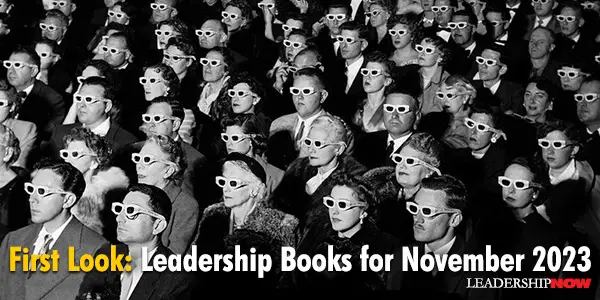
HERE'S A LOOK at some of the best leadership books to be released in November 2023 curated just for you. Be sure to check out the other great titles being offered this month.
Every investment plan under the sun is, at best, an informed speculation of what may happen in the future, based on a systematic extrapolation from the known past. Same as Ever reverses the process, inviting us to identify the many things that never, ever change. With his usual elan, Morgan Housel presents a master class on optimizing risk, seizing opportunity, and living your best life. Through a sequence of engaging stories and pithy examples, he shows how we can use our newfound grasp of the unchanging to see around corners, not by squinting harder through the uncertain landscape of the future, but by looking backwards, being more broad-sighted, and focusing instead on what is permanently true.
Books on innovation mostly focus on how to nurture innovative cultures and brainstorm ideas. The Heart of Innovation is the first popular book to concretely delve into what innovations really are and how to create them. Many attempts at innovation fail because customers turn out to be indifferent. The key to success is to uncover unmet authentic demand; what customers cannot be indifferent to. Through fresh case studies, ranging from how SoulCycle revolutionized the fitness industry, to how IBM built an $8 billion business on the Web, to a single mother ending abuse in a slum in Africa, The Heart of Innovation explores how authentic demand is often hidden or taken for granted.
Healthy communication is essential in any professional or personal relationship. When the lines of communication are frayed or broken, the resulting drama, unnecessary conflict, and inefficiency often lead to 'dropping the ball'. Better communication yields better results. It's a no-brainer―honest conversations build deeper, more productive relationships. It may seem simple in theory, but healthy communication is one of the most challenging things to master in practice. The Communication Code helps you set up conversations and communication in a way that creates a win-win scenario for everyone involved.
What is “being geeky?” It’s being a perennially curious person, one who's not afraid to tackle hard problems and embrace unconventional solutions. McAfee shows how the geeks have created a new culture based around four norms: science, ownership, speed, and openness. The geek way seems odd at first. It's not deferential to experts, fond of planning and process, afraid of mistakes, or obsessed with "winning." But it explains everything from why Montessori babies turn out to be creative tinkerers to how newcomers are disrupting industry after industry (and still just getting started). When all four norms are in place, a culture emerges that is freewheeling, fast-moving, egalitarian, evidence-driven, argumentative, and autonomous. Why does the geek way work so much better?
The logical, inspirational, and simplified approach you need to lead through unprecedented chaos―and help your teams and organizations thrive In today’s world of near-constant disruption, every leader faces a slew of conflicting demands involving employees of different generations, cultures, and age groups; one of history’s tightest labor markets; and never-ending geopolitical, climate, financial, and health challenges. Lead Through Anything provides simple, tested and actionable strategies to help you continually level-up your impact as an individual, manager, and leader.
In Areté, Brian Johnson integrates ancient wisdom, modern science, and practical tools to, as per the sub-title of the book, help you win the ultimate game of life and fulfill your destiny. What Brian has developed is much more than a bunch of coping mechanisms for the over-stressed modern person; although that would be an improvement for most of us. He's developed a training program for the soul. Commit to this training and you will gain the ability to transmute your biggest problems, your darkest days, into unstoppable courage, endless enthusiasm, and an unshakable faith in the future. This book will change your life.
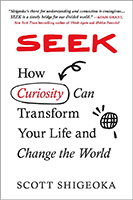 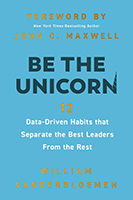 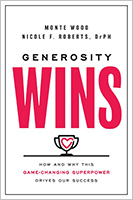 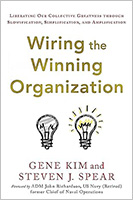
“... a mind needs books as a sword needs a whetstone, if it is to keep its edge.” — George R.R. Martin, A Game of Thrones
Posted by Michael McKinney at 07:09 AM
|
BUILD YOUR KNOWLEDGE


How to Do Your Start-Up Right STRAIGHT TALK FOR START-UPS 
Grow Your Leadership Skills NEW AND UPCOMING LEADERSHIP BOOKS 
Leadership Minute BITE-SIZE CONCEPTS YOU CAN CHEW ON 
Classic Leadership Books BOOKS TO READ BEFORE YOU LEAD |
|